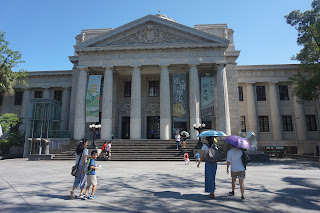Continue Chapter 1
A)
National
Museum of Singapore
|
Photo 3: National Museum of
Singapore
|
The exhibited items in the museum are the historical
and archaeological value from Singapore and other place in Asia. In the early
year of 1965, after Singapore have independence, the museum featured exhibits
on history ethnology and arts of Singapore and the region.
|
Photo 4: The Glass
Passage
|
Inside the museum, there are a glass passage which has
been designed to blend into the old neo-Palladian architecture with frameless
glass-form. The corridor is built for visitors’ access through the old building
to the new extension building and also visitors will have a clear view of the
old 19th century neo-Palladian architecture.
B)
|
Photo 5: National Taiwan
Museum
|
National
Taiwan Museum[2]
is one of the oldest museum has witnessed major changes for the island and its
people, culture of the country which exhibits the story of Taiwan’s land,
environment, flora and fauna, culture and history and all grand old
colonial-era building.
It
was established in 1908 and was built by Japanese colonial government in Taiwan
and was name Taiwan Viceroy’s Office Museum. In 1949 after relocation of the
National Government of the Republic of China to Taiwan. The museum’s name was
change to Taiwan Provincial Museum until 1999, under the purview of the central
government and experienced a new naming as National Taiwan Museum.
The
museum was designed by Japanese Architect. The structure itself built in
reinforced concrete (RC) with load-bearing brick walls and it was an advanced
technology in the early 20th century. The roof was constructed of
cypress and covered with copper tiles. The colonnade and balcony were
constructed on the south façade of the museum in consideration of the
subtropical climate of Taipei.[3]
|
Photo 6: The Dome
|
During
the past from the early time, they have already built the museum based on the
culture from its own country and remain the old structure and building until
now. The building of the museum have to remaining the same even there’s a
restoration after the World War II because the government wanted to show to the
tourist, local peoples and also for the young generation about the history of
the museum, and to show what have been collected from the past. Therefore, the
museum is been open for public purpose and it also allow everyone participate
to have activities or event in the museum. During the past, there is not much
of activities or event to be held, so people may just visit the museum for
normal visit but now, new generation like now, the government and the director
of the museum allow students or publisher to held activities in the museum so
that it could attract peoples such as students, tourists to come for visit.




Comments
Post a Comment